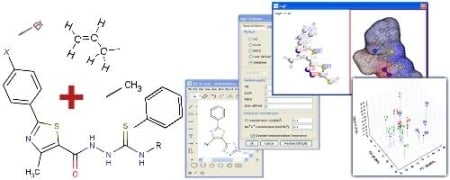Study of the Relationships between the Structure, Lipophilicity and Biological Activity of Some Thiazolyl-carbonyl-thiosemicarbazides and Thiazolyl-azoles
Abstract
:1. Introduction
2. Results and Discussion
2.1. Chemistry
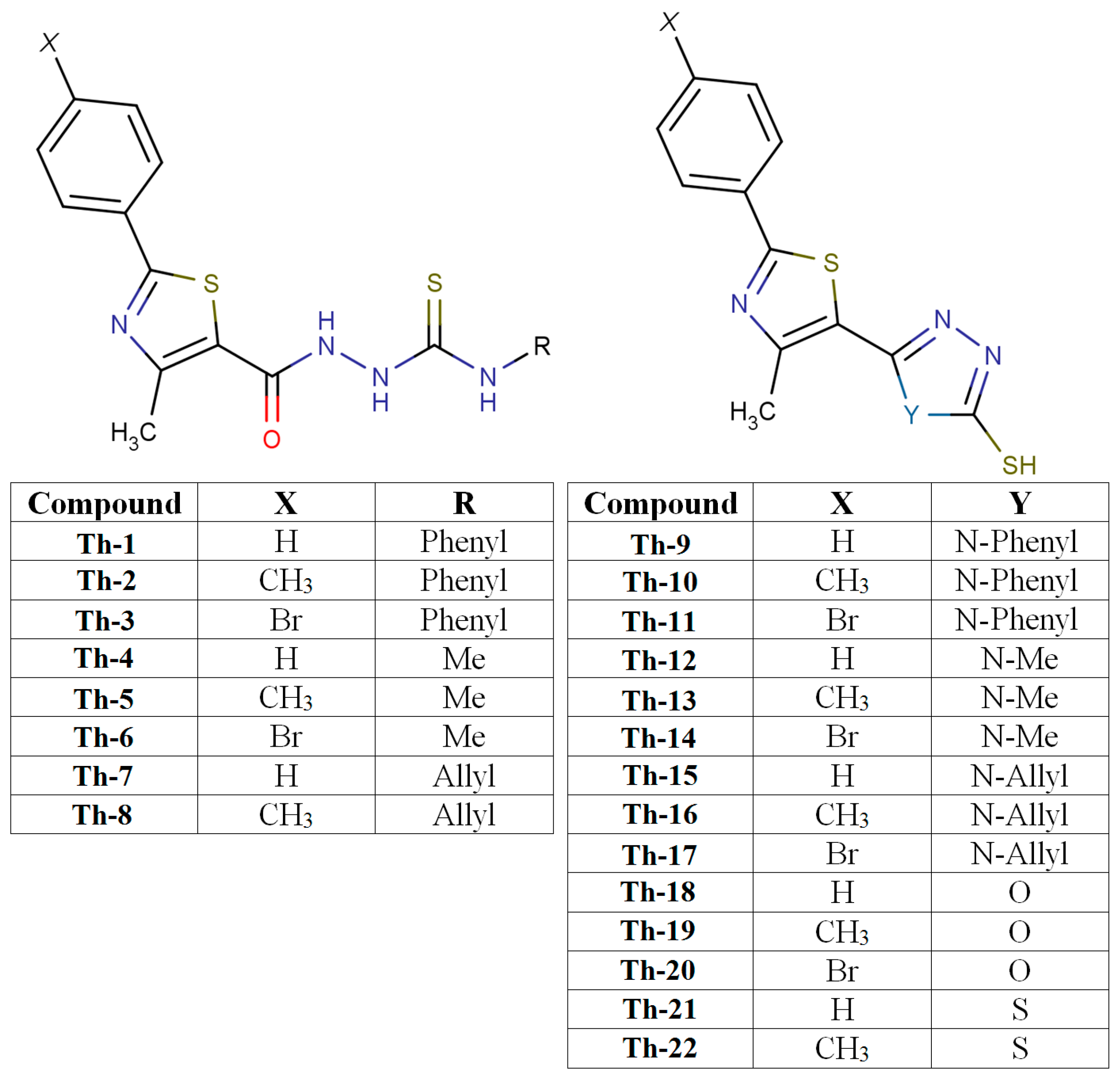
2.2. Lipophilicity Evaluation of the Studied Compounds

| Group | Compd. | RM0 | Mean ± SD | b | Mean ± SD | r a | Mean ± SD |
|---|---|---|---|---|---|---|---|
| A | Th-1 | 1.369 | 1.338 ± 0.213 | −2.627 | −2.623 ± 0.165 | 0.987 | 0.979 ± 0.005 |
| Th-2 | 1.595 | −2.853 | 0.980 | ||||
| Th-3 | 1.600 | −2.739 | 0.979 | ||||
| Th-4 | 0.986 | −2.355 | 0.979 | ||||
| Th-5 | 1.161 | −2.502 | 0.976 | ||||
| Th-6 | 1.398 | −2.740 | 0.981 | ||||
| Th-7 | 1.195 | −2.484 | 0.972 | ||||
| Th-8 | 1.398 | −2.685 | 0.975 | ||||
| B | Th-9 | 1.479 | 1.779 ± 0.435 | −2.630 | −3.012 ± 0.680 | 0.965 | 0.927 ± 0.034 |
| Th-10 | 1.754 | −2.948 | 0.954 | ||||
| Th-11 | 2.020 | −3.133 | 0.912 | ||||
| Th-12 | 1.305 | −2.463 | 0.899 | ||||
| Th-13 | 1.565 | −2.672 | 0.898 | ||||
| Th-14 | 1.630 | −2.659 | 0.876 | ||||
| Th-15 | 1.664 | −2.905 | 0.943 | ||||
| Th-16 | 1.783 | −2.962 | 0.921 | ||||
| Th-17 | 2.808 | −4.737 | 0.974 | ||||
| C | Th-18 | 0.540 | 0.508 ± 0.168 | −1.840 | −1.354 ± 0.279 | 0.951 | 0.925 ± 0.018 |
| Th-19 | 0.286 | −1.134 | 0.920 | ||||
| Th-20 | 0.393 | −1.283 | 0.921 | ||||
| Th-21 | 0.620 | −1.286 | 0.900 | ||||
| Th-22 | 0.701 | −1.227 | 0.931 |
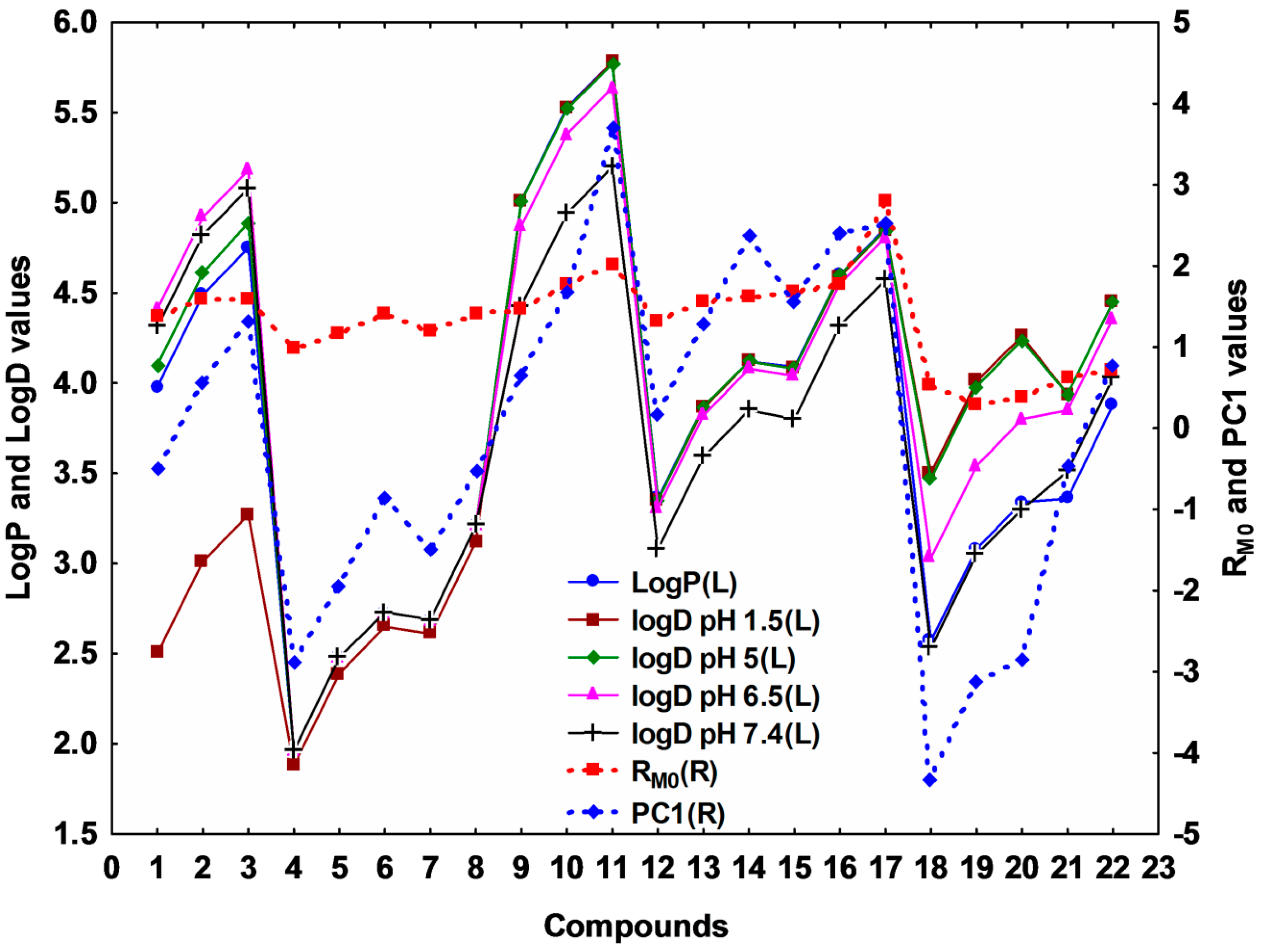
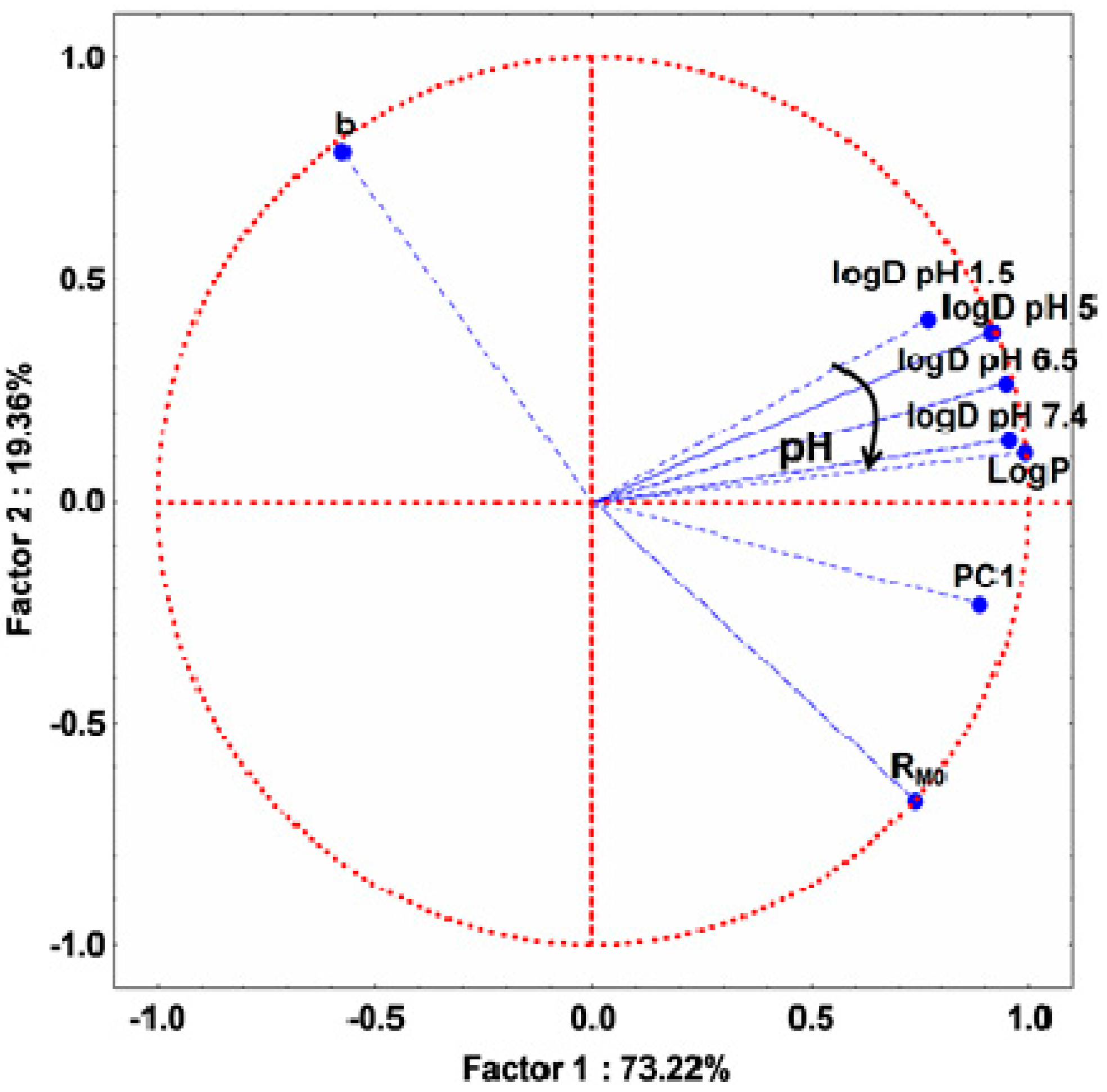


2.3. Antioxidant and Anti-Inflammatory Effects of the Studied Compounds
| Comp. | Leukocytes | PMN | PA | PI | NO | TOS | TAR | OSI |
|---|---|---|---|---|---|---|---|---|
| Th-1 | 5587.5 ± 455 | 60.4 ± 4.1 | 18.5 ± 1.8 | 21.5 ± 4.6 | 50.479 ± 5.7 | 51.622 ± 6.2 | 1.108 ± 0.003 | 4.66 ± 2.2 |
| Th-2 | 6543 ± 271 | 60.6 ± 3.1 | 22.5 ± 2.8 | 21.5 ± 2.8 | 51.827 ± 6.3 | 63.265 ± 5.4 | 1.099 ± 0.003 | 5.76 ± 5.3 |
| Th-3 | 4987 ± 133 | 63.6 ± 3.9 | 31 ± 1.8 | 21.5 ± 0.9 | 52.838 ± 8.9 | 39.601 ± 7.9 | 1.095 ± 0.003 | 3.62 ± 2.9 |
| Th-4 | 12,218.8 ± 1341 | 82.8 ± 4.1 | 29 ± 1.8 | 22.5 ± 3.5 | 47.501 ± 2.8 | 49.823 ± 3.6 | 1.109 ± 0.006 | 4.49 ± 3.6 |
| Th-5 | 11,633.3 ± 154 | 59.8 ± 3.6 | 22.5 ± 0.9 | 19.5 ± 2.3 | 47.024 ± 8.9 | 51.557 ± 17.1 | 1.096 ± 0.001 | 4.7 ± 3.1 |
| Th-6 | 6056.25 ± 862 | 70.4 ± 2.9 | 18 ± 1.5 | 13 ± 3.2 | 50.591 ± 9.1 | 43.108 ± 5.6 | 1.097 ± 0.006 | 3.93 ± 2.6 |
| Th-7 | 6356.25 ± 66 | 73.2 ± 4.0 | 53.5 ± 3.5 | 20.5 ± 0.9 | 54.355 ± 6.2 | 44.073 ± 3.8 | 1.107 ± 0.003 | 3.98 ± 3.8 |
| Th-8 | 5718.75 ± 104 | 66.6 ± 1.0 | 21 ± 1.1 | 21.5 ± 0.9 | 48.793 ± 5.5 | 55.664 ± 4.2 | 1.107 ± 0.002 | 5.03 ± 4.1 |
| Th-9 | 9000 ± 428 | 67.4 ± 3.0 | 20.5 ± 0.9 | 21 ± 7.0 | 65.479 ± 4.8 | 68.780 ± 16.2 | 1.101 ± 0.001 | 6.25 ± 5.2 |
| Th-10 | 5606.25 ± 154 | 61.2 ± 3.4 | 23 ± 1.1 | 20.5 ± 0.9 | 65.142 ± 5.3 | 54.164 ± 5.4 | 1.095 ± 0.003 | 4.95 ± 5.4 |
| Th-11 | 11,137.5 ± 483 | 86.4 ± 2.6 | 19.75 ± 2.4 | 21 ± 1.1 | 66.799 ± 5.9 | 66.394 ± 8.9 | 1.092 ± 0.003 | 6.08 ± 4.9 |
| Th-12 | 8456.25 ± 565 | 78.6 ± 1.0 | 20 ± 1.5 | 22.5 ± 3.5 | 70.029 ± 6.4 | 90.592 ± 4.2 | 1.095 ± 0.004 | 8.27 ± 4.2 |
| Th-13 | 10,172 ± 331 | 80.8 ± 3.0 | 27.5 ± 0.9 | 25.5 ± 2.8 | 75.451 ± 6.9 | 50.886 ± 5.6 | 1.1 ± 0.012 | 4.63 ± 3.6 |
| Th-14 | 10,172 ± 520 | 75.4 ± 4.5 | 23.5 ± 0.9 | 28 ± 2.1 | 86.04 ± 2.9 | 66.876 ± 9.7 | 1.097 ± 0.006 | 6.1 ± 4.7 |
| Th-15 | 9982.5 ± 81 | 77.4 ± 5.1 | 29 ± 3.2 | 24 ± 4.3 | 71.630 ± 5.9 | 69.171 ± 4.4 | 1.094 ± 0.006 | 6.32 ± 4.4 |
| Th-16 | 9225 ± 333 | 77.4 ± 1.9 | 27 ± 1.1 | 21.2 ± 1.0 | 63.091 ± 5.1 | 66.681 ± 9.1 | 1.103 ± 0.009 | 6.04 ± 4.1 |
| Th-17 | 10,147.5 ± 528 | 75.4 ± 5.2 | 19.5 ± 0.9 | 15 ± 3.5 | 60.479 ± 11.8 | 69.962 ± 5.2 | 1.093 ± 0.003 | 6.38 ± 5.2 |
| Th-18 | 4575 ± 805 | 63.7 ± 2.4 | 56 ± 8.6 | 17 ± 1.9 | 43.23 ± 3.9 | 78.089 ± 14.1 | 1.118 ± 0.006 | 6.98 ± 4.1 |
| Th-19 | 7443.75 ± 1172 | 72.8 ± 5.0 | 13.5 ± 2.78 | 20 ± 1.5 | 45.198 ± 2.2 | 79.849 ± 12 | 1.119 ± 0.009 | 7.13 ± 5.9 |
| Th-20 | 4837.5 ± 1305 | 59.2 ± 5.6 | 20 ± 1.5 | 16 ± 3.0 | 43.288 ± 5.0 | 81.022 ± 13.2 | 1.106 ± 0.003 | 7.32 ± 3.2 |
| Th-21 | 3000 ± 241 | 52.6 ± 2.1 | 23 ± 1.9 | 14.5 ± 4.6 | 43.737 ± 6.2 | 67.137 ± 10.6 | 1.114 ± 0.007 | 6.03 ± 4.5 |
| Th-22 | 5812.5 ± 399 | 66.4 ± 0.8 | 23.5 ± 0.9 | 35 ± 8.2 | 52.08 ± 8.1 | 56.694 ± 7.9 | 1.105 ± 0.001 | 5.13 ± 4.9 |
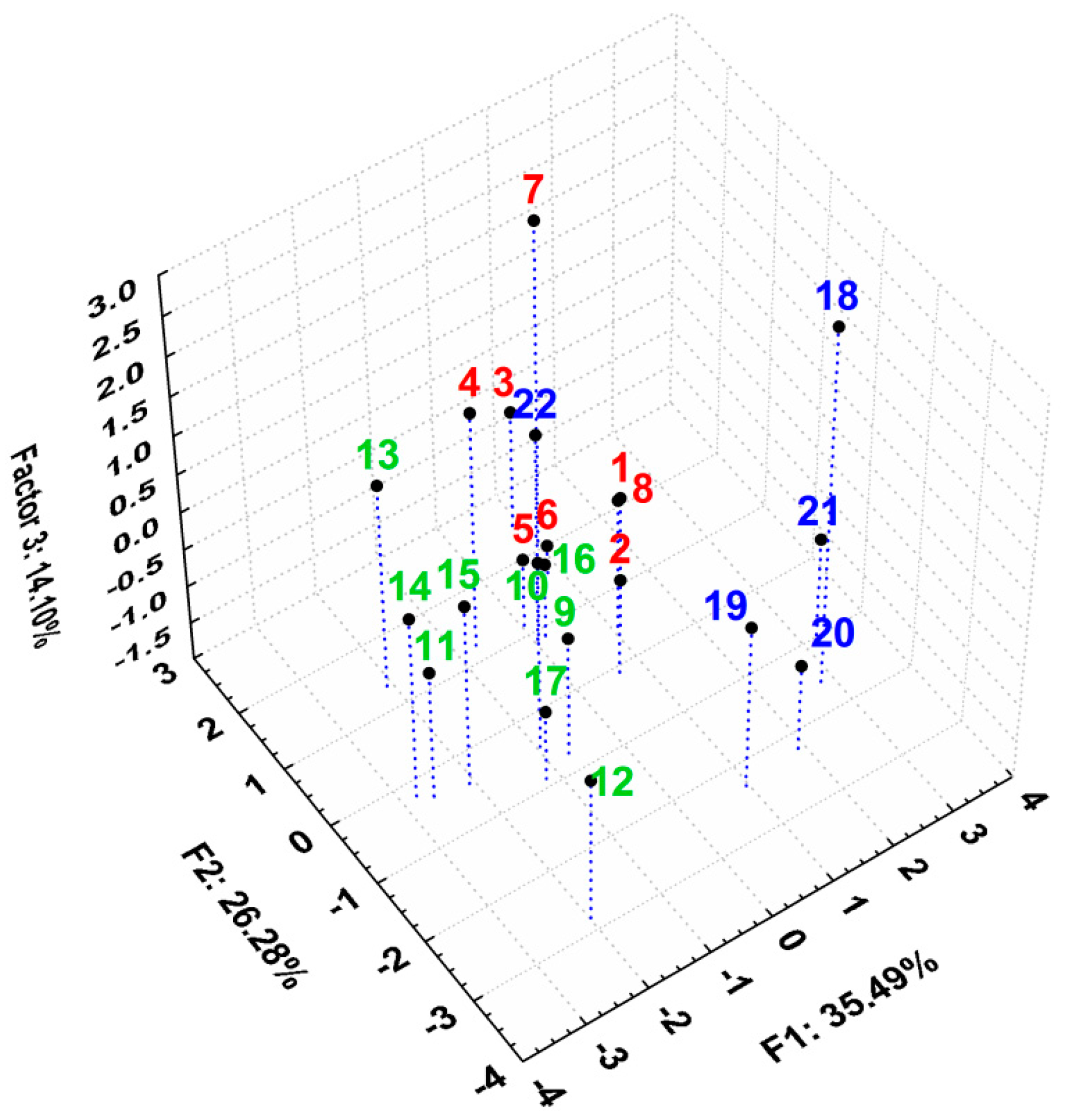
2.4. Comparative Evaluation of Both Lipophilicity Indices and Antioxidant and Anti-Inflammatory Activities Evaluation for the Studied Compounds
| L | PMN | PA | PI | NO | TOS | TAR | OSI | RM0 | b | PC1 | |
|---|---|---|---|---|---|---|---|---|---|---|---|
| L | 1.000 | 0.735 | −0.175 | 0.250 | 0.522 | 0.025 | −0.455 | 0.043 | 0.453 | −0.469 | 0.313 |
| PMN | 1.000 | 0.016 | 0.281 | 0.576 | 0.086 | −0.305 | 0.098 | 0.398 | −0.384 | 0.354 | |
| PA | 1.000 | −0.008 | −0.111 | −0.162 | 0.291 | −0.174 | −0.166 | 0.071 | −0.318 | ||
| PI | 1.000 | 0.443 | −0.105 | −0.127 | −0.098 | −0.009 | 0.153 | 0.320 | |||
| NO | 1.000 | 0.109 | −0.629 | 0.135 | 0.600 | −0.474 | 0.741 | ||||
| TOS | 1.000 | 0.178 | 0.999 | −0.206 | 0.208 | −0.091 | |||||
| TAR | 1.000 | 0.142 | −0.782 | 0.704 | −0.741 | ||||||
| OSI | 1.000 | −0.178 | 0.184 | −0.063 | |||||||
| RM0 | 1.000 | −0.965 | 0.804 | ||||||||
| b | 1.000 | −0.621 | |||||||||
| PC1 | 1.000 |

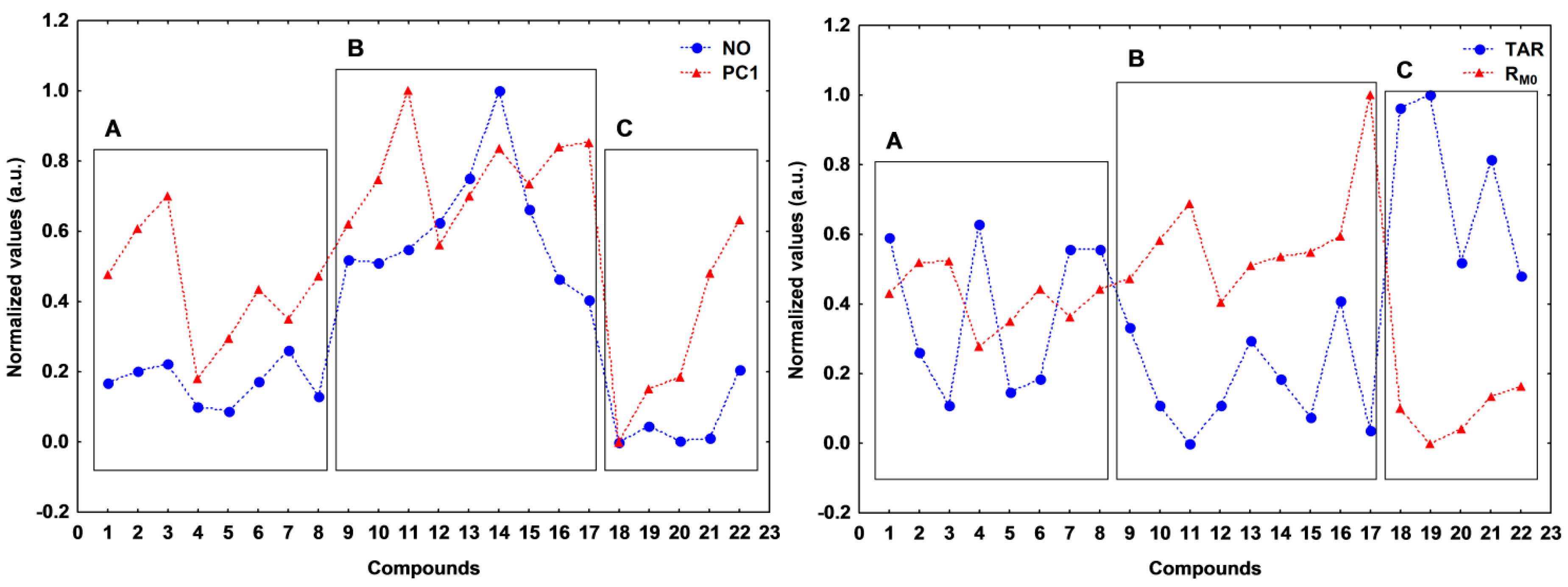
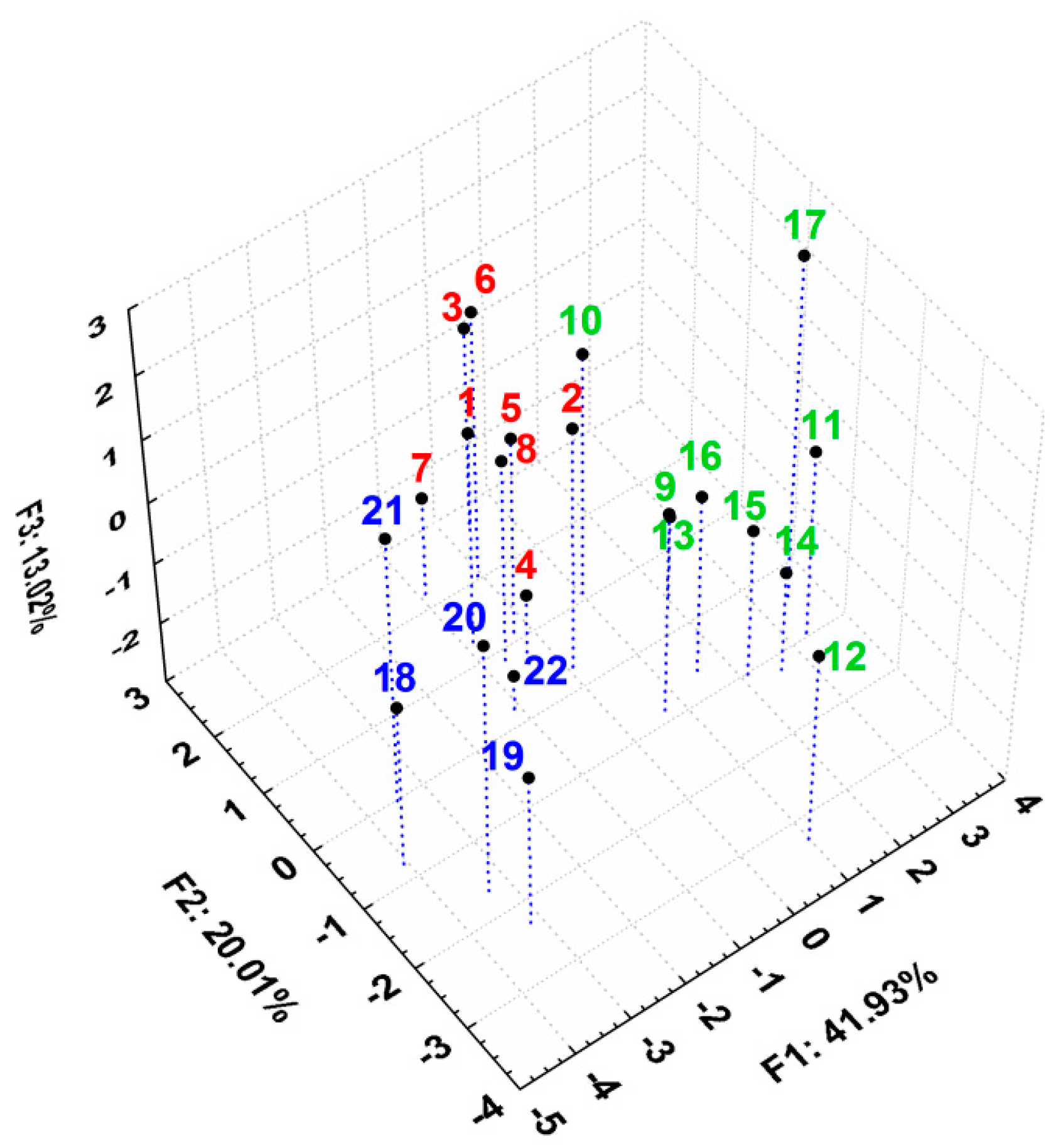
3. Experimental Section
3.1. Chromatographic Procedure
3.2. Prediction of Partitioning and Distribution Coefficients
3.3. Biological Activity Measurements
3.4. Statistical Analysis
4. Conclusions
Supplementary Materials
Acknowledgments
Author Contributions
Conflicts of Interest
References
- Testa, B.; Crivori, P.; Reist, M.; Carrupt, P.-A. The influence of lipophilicity on the pharmacokinetic behavior of drugs: Concepts and examples. Perspect. Drug Discov. Des. 2000, 19, 179–211. [Google Scholar] [CrossRef]
- Van de Waterbeemd, H. Calculation of drug lipophilicity—The hydrophobic fragmental constant approach. Quant. Struct. Act. Relatsh. 1993, 12. [Google Scholar] [CrossRef]
- Sangster, J. Octanol-Water Partition Coefficients: Fundamentals and Physical Chemistry, 1st ed.; John Wiley & Sons Ltd.: Hoboken, NJ, USA, 1997. [Google Scholar]
- Mannhold, R.; Poda, G.I.; Ostermann, C.; Tetko, I.V. Calculation of molecular lipophilicity: State-of-the-art and comparison of log P methods on more than 96,000 compounds. J. Pharm. Sci. 2009, 98, 861–893. [Google Scholar] [CrossRef] [PubMed]
- Leo, A.; Hansch, C.; Elkins, D. Partition coefficients and their uses. Chem. Rev. 1971, 71, 525–616. [Google Scholar] [CrossRef]
- Tiperciuc, B.; Sârbu, C. Prediction of the chromatographic retention (lipophilicity) of some new methyl-thiazole-oxadiazoline derivatives by multivariate regression methods. J. Liq. Chromatogr. Relat. Technol. 2006, 29, 2257–2270. [Google Scholar] [CrossRef]
- Durcekova, T.; Boronova, K.; Mocak, J.; Lehotay, J.; Cizmarik, J. QSRR models for potential local anaesthetic drugs using high performance liquid chromatography. J. Pharm. Biomed. Anal. 2012, 59, 209–216. [Google Scholar] [CrossRef] [PubMed]
- Pyka, A.; Miszczyk, M. Chromatographic evaluation of the lipophilic properties of selected pesticides. Chromatographia 2005, 61, 37–42. [Google Scholar] [CrossRef]
- Biagi, G.L.; Barbaro, A.M.; Sapone, A.; Recanatini, M. Determination of lipophilicity by means of reversed-phase thin-layer chromatography I. Basic aspects and relationship between slope and intercept of TLC equations. J. Chromatogr. A 1994, 662, 341–361. [Google Scholar] [CrossRef]
- Soczewiński, E.; Wachtmeister, C.A. The relation between the composition of certain ternary two-phase solvent systems and RM values. J. Chromatogr. A 1962, 7, 311–320. [Google Scholar] [CrossRef]
- Sârbu, C.; Casoni, D.; Darabantu, M.; Maiereanu, C. Quantitative structure—Retention activity relationship of some 1,3-oxazolidine systems by RP-HPTLC and PCA. J. Pharm. Biomed. Anal. 2004, 35, 213–219. [Google Scholar] [CrossRef] [PubMed]
- Alvarez-Coque, M.C.G.; Lapasió, J.R.T. Quantitation of hydrophobicity in micellar liquid chromatography. TrAC Trends Anal. Chem. 1999, 18, 533–543. [Google Scholar] [CrossRef]
- Fuchs, B.; Süss, R.; Teuber, K.; Eibisch, M.; Schiller, J. Lipid analysis by thin-layer chromatography—A review of the current state. J. Chromatogr. A 2011, 1218, 2754–2774. [Google Scholar] [CrossRef] [PubMed]
- Maćkiewicz, A.; Ratajczak, W. Principal components analysis. Comput. Geosci. 1993, 19, 303–342. [Google Scholar] [CrossRef]
- Mannhold, R.; Cruciani, G.; Dross, K.; Rekker, R.F. Multivariate analysis of experimental and calculative descriptors for molecular lipophilicity. J. Comput. Aided Mol. Des. 1998, 12, 573–581. [Google Scholar] [CrossRef] [PubMed]
- Casoni, D.; Kot-Wasik, A.; Namieśnik, J.; Sârbu, C. Lipophilicity data for some preservatives estimated by reversed-phase liquid chromatography and different computation methods. J. Chromatogr. A 2009, 1216, 2456–2465. [Google Scholar] [CrossRef] [PubMed]
- Oniga, O.; Grosu, I.; Mager, S.; Simiti, I. Heterocycles LXXVIII. Electrophilic substitution 2′-phenyl-4R-2,4′-bisthiazoles. Monatsh. Chem. 1998, 129, 661–669. [Google Scholar] [CrossRef]
- Zaharia, V.; Ignat, A.; Palibroda, N.; Ngameni, B.; Kuete, V.; Fokunang, C.N.; Moungang, M.L.; Ngadjui, B.T. Synthesis of some p-toluenesulfonyl-hydrazinothiazoles and hydrazino-bis-thiazoles and their anticancer activity. Eur. J. Med. Chem. 2010, 45, 5080–5085. [Google Scholar] [CrossRef] [PubMed]
- Moldovan, C.M.; Oniga, O.; Pârvu, A.; Tiperciuc, B.; Verité, P.; Pîrnău, A.; Crişan, O.; Bojiţă, M.; Pop, R. Synthesis and anti-inflammatory evaluation of some new acyl-hydrazones bearing 2-aryl-thiazole. Eur. J. Med. Chem. 2011, 46, 526–534. [Google Scholar] [CrossRef] [PubMed]
- Tiperciuc, B.; Zaharia, V.; Colosi, I.; Moldovan, C.; Crişan, O.; Pîrnău, A.; Vlase, L.; Duma, M.; Oniga, O. Synthesis and evaluation of antimicrobial activity of some new hetaryl-azoles derivatives obtained from 2-aryl-4-methylthiazol-5-carbohydrazydes and isonicotinic acid hydrazide. J. Heterocycl. Chem. 2012, 49, 1407–1414. [Google Scholar] [CrossRef]
- Tiperciuc, B.; Pârvu, A.; Tamaian, R.; Nastasă, C.; Ionuţ, I.; Oniga, O. New anti-inflammatory thiazolyl-carbonyl-thiosemicarbazides and thiazolyl-azoles with antioxidant properties as potential iNOS inhibitors. Arch. Pharm. Res. 2013, 36, 702–714. [Google Scholar] [CrossRef] [PubMed]
- Horváth, C.; Melander, W.; Molnár, I. Solvophobic interactions in liquid chromatography with nonpolar stationary phases. J. Chromatogr. A 1976, 125, 129–156. [Google Scholar] [CrossRef]
- Apostolova, N.; Garcia-Bou, R.; Hernandez-Mijares, A.; Herance, R.; Rocha, M.; Victor, V.M. Mitochondrial antioxidants alleviate oxidative and nitrosative stress in a cellular model of sepsis. Pharm. Res. 2011, 28, 2910–2919. [Google Scholar] [CrossRef] [PubMed]
- Asadollahi, K.; Beeching, N.J.; Gill, G.V. Leukocytosis as a predictor for non-infective mortality and morbidity. QJM 2010, 103, 285–292. [Google Scholar] [CrossRef] [PubMed]
- Vastag, G.; Apostolov, S.; Perišić-Janjić, N.; Matijević, B. Multivariate analysis of chromatographic retention data and lipophilicity of phenylacetamide derivatives. Anal. Chim. Acta 2013, 767, 44–49. [Google Scholar] [CrossRef] [PubMed]
- De Faria, C.M.Q.G.; Nazaré, A.C.; Petrônio, M.S.; Paracatu, L.C.; Zeraik, M.L.; Regasini, L.O.; Silva, D.H.S.; da Fonseca, L.M.; Ximenes, V.F. Protocatechuic acid alkyl esters: Hydrophobicity as a determinant factor for inhibition of NADPH oxidase. Curr. Med. Chem. 2012, 19, 4885–4893. [Google Scholar] [CrossRef] [PubMed]
- Viswanadhan, V.N.; Ghose, A.K.; Revankar, G.R.; Robins, R.K. Atomic physicochemical parameters for three dimensional structure directed quantitative structure-activity relationships. 4. Additional parameters for hydrophobic and dispersive interactions and their application for an automated superposition of certain naturally occurring nucleoside antibiotics. J. Chem. Inf. Model. 1989, 29, 163–172. [Google Scholar]
- Klopman, G.; Li, J.-Y.; Wang, S.; Dimayuga, M. Computer automated log P calculations based on an extended group contribution approach. J. Chem. Inf. Model. 1994, 34, 752–781. [Google Scholar] [CrossRef]
- Sample Availability: Samples of the compounds Th-1–22 are available from the authors.
© 2015 by the authors. Licensee MDPI, Basel, Switzerland. This article is an open access article distributed under the terms and conditions of the Creative Commons by Attribution (CC-BY) license ( http://creativecommons.org/licenses/by/4.0/).
Share and Cite
Tamaian, R.; Moţ, A.; Silaghi-Dumitrescu, R.; Ionuţ, I.; Stana, A.; Oniga, O.; Nastasă, C.; Benedec, D.; Tiperciuc, B. Study of the Relationships between the Structure, Lipophilicity and Biological Activity of Some Thiazolyl-carbonyl-thiosemicarbazides and Thiazolyl-azoles. Molecules 2015, 20, 22188-22201. https://doi.org/10.3390/molecules201219841
Tamaian R, Moţ A, Silaghi-Dumitrescu R, Ionuţ I, Stana A, Oniga O, Nastasă C, Benedec D, Tiperciuc B. Study of the Relationships between the Structure, Lipophilicity and Biological Activity of Some Thiazolyl-carbonyl-thiosemicarbazides and Thiazolyl-azoles. Molecules. 2015; 20(12):22188-22201. https://doi.org/10.3390/molecules201219841
Chicago/Turabian StyleTamaian, Radu, Augustin Moţ, Radu Silaghi-Dumitrescu, Ioana Ionuţ, Anca Stana, Ovidiu Oniga, Cristina Nastasă, Daniela Benedec, and Brînduşa Tiperciuc. 2015. "Study of the Relationships between the Structure, Lipophilicity and Biological Activity of Some Thiazolyl-carbonyl-thiosemicarbazides and Thiazolyl-azoles" Molecules 20, no. 12: 22188-22201. https://doi.org/10.3390/molecules201219841








